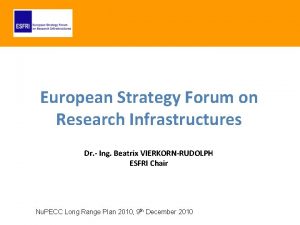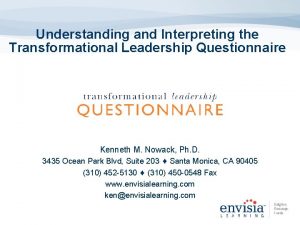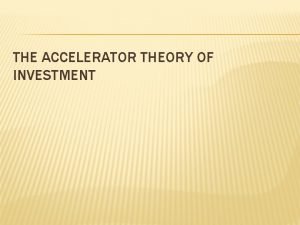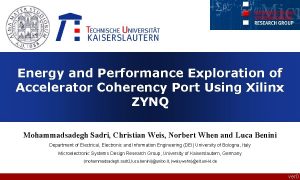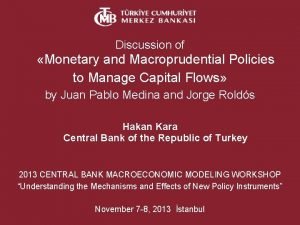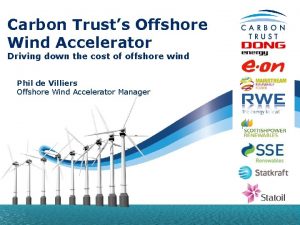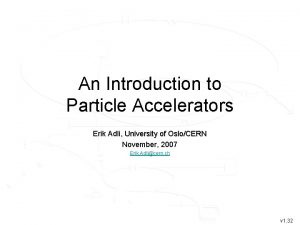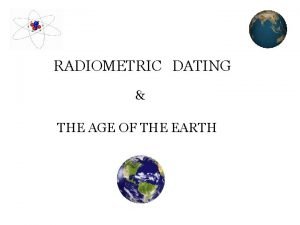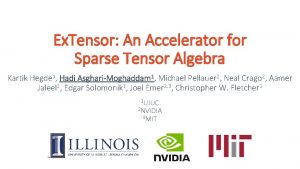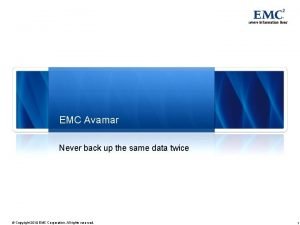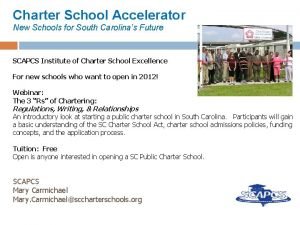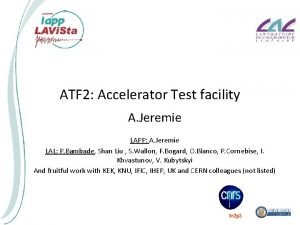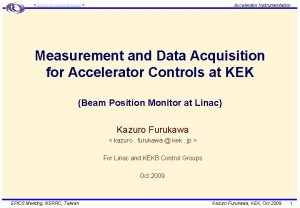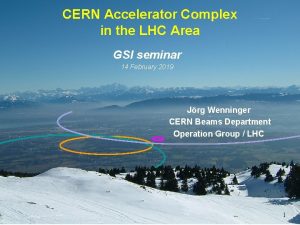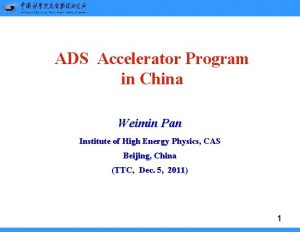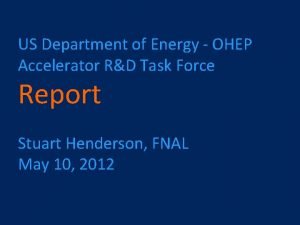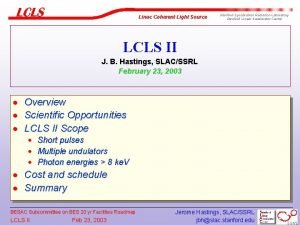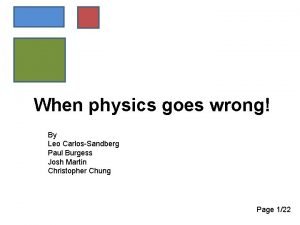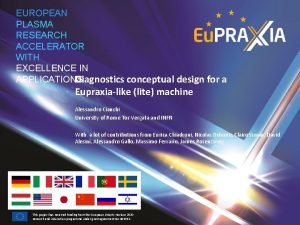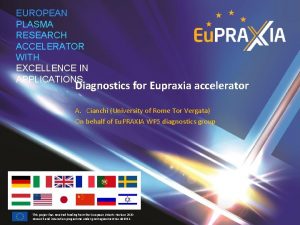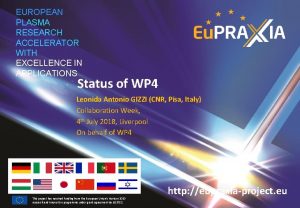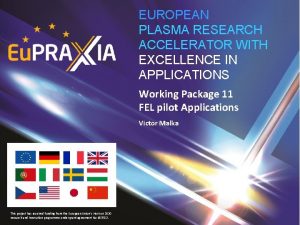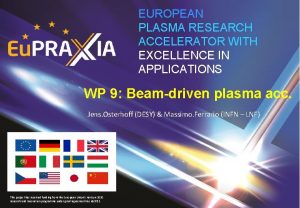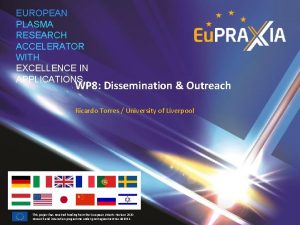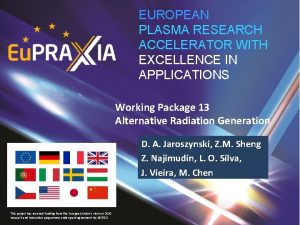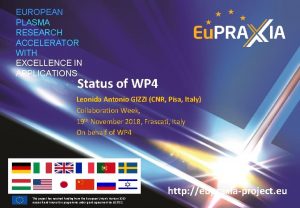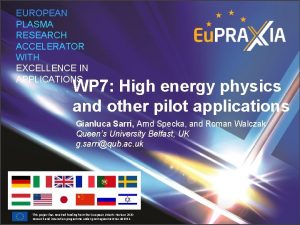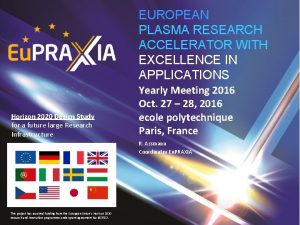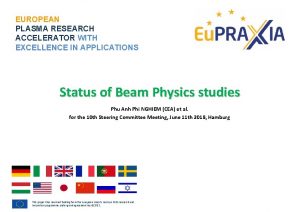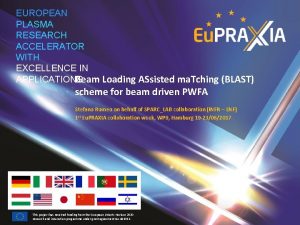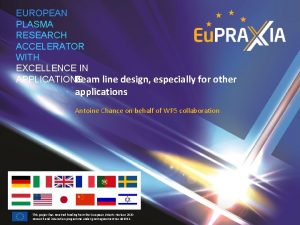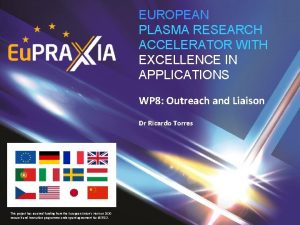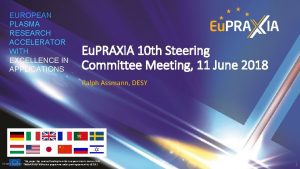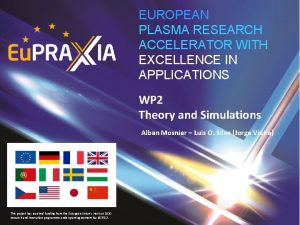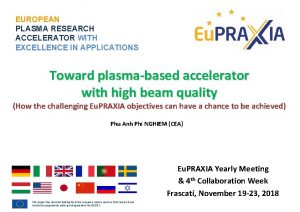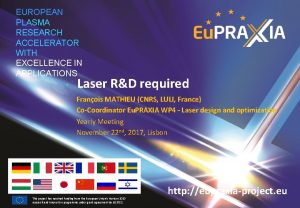EUROPEAN PLASMA RESEARCH ACCELERATOR WITH EXCELLENCE IN APPLICATIONS



































- Slides: 35

EUROPEAN PLASMA RESEARCH ACCELERATOR WITH EXCELLENCE IN APPLICATIONS Eu. PRAXIA Machine Design Eva Panofski, DESY Hamburg This project has received funding from the European Union’s Horizon 2020 research and innovation programme under grant agreement No 653782.

LWFA for future linear colliders Horizon 2020 • The collision energy in particle colliders increased exponentially in time over decades • Increase leveled off since the 1980 s: → limits in conventional accelerators (electrical breakdown, max fields in sc magnets, accelerator size, accelerator costs, …) • Plasma based acceleration proposed by Tajima and Dawson in 1979 and enabled by the invention of chirped pulse amplification (Mourou and Strickland 1985) offers: → High beam energies → Highest acceleration gradients on a short acceleration length (up to 160 Ge. V/m) Produce high beam quality and prove operational reliability Eva Panofski | Eu. PRAXIA machine design | 28 th March, 2019 2

Outline Horizon 2020 • Project overview - Eu. PRAXIA • Eu. PRAXIA implementation at DESY Hamburg • Beamline design and beam dynamic simulations • Electron beam diagnostics • Plasma acceleration • Eu. PRAXIA as a particle collider • Conclusion Eva Panofski | Eu. PRAXIA machine design | 28 th March, 2019 3

Eu. PRAXIA - Project Overview Horizon 2020 • Eu. PRAXIA (European Plasma Research Accelerator with e. Xcellence In Application) is an EU design study. • EUPRAXIA is one of two accelerator-related design studies funded by Horizon 2020. • First European research infracture dedicated to demonstrate usability of plasma accelerators ready for user applications. • Project time line: Eva Panofski | Eu. PRAXIA machine design | 28 th March, 2019 4

Participating Institutions 16 laboratories and universities from 5 EU member states 25 Associated Partners University of Strathclyde UK (as of December 2018) 1 Shanghai Jiao Tong-University, China 2 Tsinghua University Beijing, China 3 ELI Beamlines, International 4 PHLAM, Université de Lille, France Horizon 2020 STFC UK DESY University of Manchester UK Germany Universität Hamburg Germany University of Liverpool UK 5 Helmholtz-Institut Jena, Germany 6 HZDR (Helmholtz), Germany 7 LMU München, Germany 8 Wigner Fizikai Kutatóközpont, Hungary 9 CERN, International 10 Kansai Photon Science Institute, Japan 11 Osaka University, Japan 12 RIKEN SPring-8, Japan 13 Lunds Universitet, Sweden 14 Stony Brook University & Brookhaven NL, USA 15 LBNL, USA 16 UCLA, USA 17 Karlsruher Institut für Technologie, Germany 18 Forschungszentrum Jülich, Germany 19 3 Hebrew University of Jerusalem, Israel 20 Institute of Applied Physics, Russia 21 Joint Institute for High Temperatures, Russia 22 Università di Roma "Tor Vergata «, Italy 23 Queen’s University Belfast, UK 24 Ferdinand-Braun-Institut, Germany 25 University of York, UK Collaboration brings together: Imperial College London University of • Big science labs: photon science, particle physics Oxford INFN • Laser labs: high power laser science CNRS CNR • International labs: CERN, ELI SOLEIL ENEA IST-ID • Universities labs: accelerator, plasma, laser research Università di Roma CEA UK UK 14 15 16 5 13 23 10 7 25 9 16 1 14 15 4 5 18 24 4 6 17 8 9 7 3 8 2 3 12 6 22 11 13 21 20 2 Italy 1 19 France 10 11 12 Italy France Italy Portugal France Eva Panofski | Eu. PRAXIA machine design | 28 th March, 2019 "La Sapienza" Italy 5

Eu. PRAXIA - Project Overview Horizon 2020 Goal: Compact facility producing multi-Ge. V electron beams based on plasma acceleration Demonstrate plasma accelerator technology is able to provide high beam quality § Incorporate established (RF) accelerator technology § Combine expertise from accelerator & laser labs, industry, international partners § Develop new technical solutions Show benefit in size versus established RF technology Up to 5 Ge. V high brightness electron beams for various user applications: Photon science, high energy physics, FEL radiation in the X-ray regime Milestone towards plasma driven future linear collider Integration of high gradient plasma modules to short wavelength FEL Eva Panofski | Eu. PRAXIA machine design | 28 th March, 2019 6

Eu. PRAXIA - Experimental Sites Horizon 2020 Design study is site-independent. Potential sites are: • Eu. SPARC (Frascati, Italy) • SINBAD at DESY (Hamburg, Germany) Pan-European concept with 2 experimental sites: Eva Panofski | Eu. PRAXIA machine design | 28 th March, 2019 7

Beamline Layout INFN (Italy): Facility for beam-driven plasma accelerators RF Injector FEL user area 1 Undulator Plasma Accelerator FEL user area 2 electrons Current version of layout for Frascati and Hamburg machine sites ICS X-ray source user area RF Accelerator laser Horizon 2020 Plasma Accelerator Conversion & conditioning positrons Plasma Injector HEP detector test user area Ge. V-class positron user area Life-science & materials X-ray imaging user area Plasma Accelerator Conversion & conditioning Plasma Accelerator Undulator DESY (Germany): Facility for laser-driven plasma accelerators Table-top test beam user area Ultracompact positron source user area Laser RF Injector Credit: A. Walker Eva Panofski | Eu. PRAXIA machine design | 28 th March, 2019 FEL user area 1 FEL user area 2 8

SINBAD @ DESY Hamburg Horizon 2020 New accelerator concepts will be tested at DESY within the SINBAD facility (former DORIS ring) AXSIS beam and laboratory Kärtner/Assmann/Fromme/Chapman ACHIP External injection with dielectric stuctures Reserve for additional projects Laser labs Hartl/Kärtner Optical to THz ARES 150 Me. V S band linac generating ultra-short e- bunch Testing site for LPWA (target energy 1 Ge. V) 1 Ge. V FEL driven by LPWA Eva Panofski | Eu. PRAXIA machine design | 28 th March, 2019 9

Eupraxia @ DESY Hamburg Horizon 2020 Proposal: Host Eu. PRAXIA under the infrastructure of the SINBAD facility at DESY For Configuration 2 (LPWA with external RF injector) setup close to ARES linac @ SINBAD is planned based on 3 additional TWS and an adjusted PMQ triplet for matching the electron beam into the plasma Eva Panofski | Eu. PRAXIA machine design | 28 th March, 2019 10

Eu. PRAXIA Beamline Design Horizon 2020 1. 5 cells standing wave Peak gradient: 117 MV/m for 6 MW input power RF pulse length: 6µs Eva Panofski | Eu. PRAXIA machine design | 28 th March, 2019 11

Eu. PRAXIA Beamline Design Horizon 2020 Normal conducting S-band technology: • 2. 998 GHz normal conducting linac • 10 -50 Hz rep. rate, single bunch mode • • RF cavities embedded in solenoids RI design, similar to Swiss. FEL injector cavities 4. 15 m long 20 MV/m for 45 MW input power → About 50 Me. V energy gain per cavity expected with our RF station Eva Panofski | Eu. PRAXIA machine design | 28 th March, 2019 12

Bunch Compression Simultaneous compression and acceleration of a non-yet-relativistic beam Eva Panofski | Eu. PRAXIA machine design | 28 th March, 2019 Horizon 2020 Magnetic chicane with a collimator 13

e-Bunch Requirements to Address LWFA Challenges • • Horizon 2020 Bunch duration shorter than a few fs reduce the impact field curvature reduce energy spread; Bunch arrival time jitter significantly smaller than the field wavelength (e. g. , smaller than 10 fs for 1 ps field period) acceptable shot to shot energy variation; Beam transverse size of the µm level transverse beam matching; Beam emittance as small as possible Pointing stability needs to be limited to a few µm strong focusing of the fields inside the plasma bubble. Maximum bunch charge and its stability limited by the maximum tolerable beam loading effect and by the requirements above; Beam energy chosen to reduce the space charge effect, thus allowing shorter bunch lengths for a fixed bunch charge J. Zhu et al. , “Simulation Study of an RF Injector for the LWFA Configuration at Eu. PRAXIA”, in Proc. IPAC’ 18, Vancouver, Canada (2018), paper THPAF 032. Eva Panofski | Eu. PRAXIA machine design | 28 th March, 2019 14

Beam dynamic simulations Plasma injection point Horizon 2020 Plasma injection point 240. 8 29. 8 7. 5 4. 0 0. 81 / 0. 46 0. 59/0. 34 3. 1/3. 0 0. 27 0. 23 ultra-short bunch high peak current Increased transv. emittance due to sc effects and chromatic abberation small β-function Transverse and longitudinal phase spaces at the plasma injection point Eva Panofski | Eu. PRAXIA machine design | 28 th March, 2019 15

Beam diagnostics Horizon 2020 Goal: Complete characterization of the fs beam injected in plasma • Transverse measurements in the µm (rms) range → Scintillating screen, OTR (transverse beam size) → Pepper pot, perm. quade scan, betatron-radiation, … (transv. emittance) • Longitudinal measurements in the order of a few fs (FWHM) → X-band TDS Eva Panofski | Eu. PRAXIA machine design | 28 th March, 2019 16

fs Bunch Length Diagnostics Polarizable Transverse Deflecting Structure § Novel design of TDS with tunable direction of the streaking field invented at CERN [1] Prototype manufactured at PSI § First prototype cavity [2] has been produced and characterized at PSI § High power conditioning at CERN ongoing Horizon 2020 Collaboration between: DESY-experiments involved: SINBAD, FLASHForward, FLASH 2, possibly in the future XFEL § Prototype cavity will be tested with beam at DESY (FLASHForward beamline) in 2019 § Novel beam diagnostics techniques will be tested: e. g. 3 D beam charge distribution reconstruction through tomography [3] References: [1] CLIC - note - 1067 (2016) [2] doi: 10. 18429/JACo. W-IPAC 2018 -THPAL 068 [3] doi: 10. 18429/JACo. W-IPAC 2018 -WEPAF 05 Eva Panofski | Eu. PRAXIA machine design | 28 th March, 2019 17

Plasma Acceleration New concept: 5 Ge. V stage Horizon 2020 for Submitted publication n ar. Xiv Available o Ref. : Ferran Pousa, Martinez de la Ossa, Brinkmann, Assmann, ar. Xiv: 1811. 07757 Eva Panofski | Eu. PRAXIA machine design | 28 th March, 2019 18

Plasma Acceleration New concept: 5 Ge. V stage Horizon 2020 Plot courtesy Angel Ferran Pousa ATHENA can prove this concept at lower energy (1 Ge. V) and lower charge. Then Eu. PRAXIA for the 5 Ge. V case! Eva Panofski | Eu. PRAXIA machine design | 28 th March, 2019 19

Plasma Acceleration for Colliders. Future concept: 500 Ge. V Horizon 2020 500 Ge. V shaded area: • is for speculative extrapolation to high energy • requires simulations and 5 Ge. V case working Eu ILC TDR Vol. 1 PR AX IA Eva Panofski | Eu. PRAXIA machine design | 28 th March, 2019 & 100 stages CLIC CDR Vol. 1 20

Conclusion Horizon 2020 • Eu. PRAXIA is a conceptual design study for a 5 Ge. V electron accelerator • Based on laser and beam driven plasma acceleration • Pan-European concept in Italy, Germany, France, Portugal and the UK with two experimental sites • Eu. PRAXIA is addressing the quality issue of plasma accelerators • Several new concepts (reduce energy spread, synchronization, …) have been developed over the last years • Provide high quality beams to multiple user areas: – Electron beams at 1 - 5 Ge. V – Positrons at 1 Me. V - 1 Ge. V Eva Panofski | Eu. PRAXIA machine design | 28 th March, 2019 21

Dissemination Horizon 2020 www. eupraxia-project. eu #Eu. PRAXIA #plasma #accelerator Eva Panofski | Eu. PRAXIA machine design | 28 th March, 2019 22

Thank you for your attention! Horizon 2020 16 Participants 25 Associated Partners (as of December 2018) Eva Panofski | Eu. PRAXIA machine design | 28 th March, 2019 23

Horizon 2020 Backup Slides Eva Panofski | Eu. PRAXIA machine design | 28 th March, 2019 24

Beamline Layout - INFN Italy Beamline BB-A: Radiation sources INFN (Italy): Facility for beam-driven plasma accelerators RF Injector laser FEL user area 1 (BU 1) Undulator Plasma Accelerator RF Accelerator R&D user area (BU 6 -1) FEL user area 2 (BU 2) ICS X-ray source user area (BU 3) Accelerator R&D user area (BU 6 -2) Plasma Accelerator electrons positrons Horizon 2020 Conversion & conditioning HEP detector test user area (BU 5) Ge. V-class positron user area (BU 4) Beamline BB-B: Ge. V-class positrons & HEP detector test stand 1. FEL with initial focus on application X 1 Credit: A. Walker Towards attosecond sources with pump-probe capability. Two-colour FEL scheme. 2. Ge. V-class positrons & HEP detector tests Best exploitation of the 500 Me. V PWFA beam driver. Outstanding temporal and spatial resolution. 3. Compton source Less complex with PWFA (1 laser 1 e-beam). Eva Panofski | Eu. PRAXIA machine design | 28 th March, 2019 25

Beamline Layout DESY Germany Beamline LB-C: X-ray imaging – life sciences & materials Plasma Injector Life-science & materials X-ray imaging user area (LU 5) Accelerator R&D user area (LU 6 -3) Horizon 2020 DESY (Germany): Facility for laser-driven plasma accelerators Accelerator R&D user area (LU 6 -2) Plasma Injector Plasma Accelerator Conversion & conditioning Beamline LB-B: Ultracompact positron beam source & table-top test beam Laser RF Injector Accelerator R&D user area (LU 6 -1) Plasma Accelerator Undulator Beamline LB-A: FEL Table-top test beam user area (LU 4) Ultracompact positron source user area (LU 3) FEL user area 1 (LU 1) FEL user area 2 (LU 2) 1. FEL with initial focus on X 2 (e. g. medical) Credit: A. Walker Towards attosecond sources with pump-probe capability 2. Ultracompact positrons beam source & table-top test beam LWFA compact and efficient to produce low energy e-. High repetition capability. Outstanding temporal and spatial resolution. 3. X-ray imaging for life sciences & materials Fully optical and most compact set-up. High repetition capability. Small source size combined with high flux capability. Eva Panofski | Eu. PRAXIA machine design | 28 th March, 2019 26

Photocathode Laser System • • • Horizon 2020 Yb doped laser Pulse energy ≥ 1 m. J Central wavelength: 1030 nm (4 th harmonic 257 nm) Pulse length range tunable: 180 fs-10 ps FWHM Laser setup tested in I. Hartl‘s laboratory (now being moved to the PC laser room). It is operated by L. Winkelmann and S. Pumpe for experiments on laser shaping. Eva Panofski | Eu. PRAXIA machine design | 28 th March, 2019 • • DESY-developed transverse flattop shaping system Range for flat-top shaping: 20µm-0. 2 mm RMS 27

Transverse Deflecting Structures and Crab Cavities The longitudinal distribution of the e-bunch is mapped into the transverse one thanks to the time dependent transverse deflecting field Horizon 2020 Working Principle: β(s 0) Δφy β(s) Fig. Credits: D. Malyutin Ph. D thesis e-bunch: • Kinetic Energy E • Vertical geometric emittance εy Magnetic Lattice: • Phase advance in y plane Δφy • Beta function in the TDS βy(s 0) RF cavity: • Frequency f = ω/(2π) • Peak deflection voltage Vy In this example streaking on y plane. Eva Panofski | Eu. PRAXIA machine design | 28 th March, 2019 Frequency ~12 GHz (X-band) allows having 4 times higher resolution than ~3 GHz (S-band) Cfr: P. Emma et al. , LCLS-TN-00 -12 M. Röhrs et. al. , PRSTAB 12 050704 (2009) 28

Examples of beam characterization Horizon 2020 Simulations using Elegant (3 D space charge effect not yet included) Reconstruction of 3 D charge density distribution Longitudinal Phase Space Original phase space + reconstruction Longitudinal Resolution = 3. 4 fs Original Cfr: D. Marx et al. , Nucl. Inst. And Meth, A (2018). Reconstructed Longitudinal Charge Profile Longitudinal Resolution = 0. 85 fs Cfr: D. Marx et al. , J. Phys. : Conf. Ser. , vol. 874, p. 012077, (2017). Longitudinal Resolution = 0. 42 fs Eva Panofski | Eu. PRAXIA machine design | 28 th March, 2019 29

Plasma Acceleration Incorporate new concepts Horizon 2020 Modulated plasma density: FODO type accelerator with electrons accelerated on both acceleration slopes Simulated energy spread reduced by factor 4 Eva Panofski | Eu. PRAXIA machine design | 28 th March, 2019 30

Plasma Acceleration Incorporate new concepts Horizon 2020 Solve external timing for laser driven plasma accelerators and achieve sub-femtosecond timing jitter Eva Panofski | Eu. PRAXIA machine design | 28 th March, 2019 31

Horizon 2020 Start settings Eu. PRAXIA RF linac: WP 4 Initial bunch charge (p. C) rms laser spot size (mm) rms laser pulse length (ps) Gun peak gradient (MV/m) Gun phase (deg) TWS 1 -5 peak gradient (MV/m) TWS 1 phase (deg) (rel. on crest) TWS 2 phase (deg) (rel. on crest) TWS 3 phase (deg) (rel. on crest) TWS 4 phase (deg) (rel. on crest) TWS 5 phase (deg) (rel. on crest) High charge gun solenoid field Bz (T) Low charge gun solenoid field Bz (T) TWS 1 solenoids Bz (T) TW 2 solenoids Bz (T) TW 3 -5 solenoids Bz (T) 50 0. 17 2. 9 110 0. 0 25. 5 -87. 0 -55. 0 -41. 0 0. 24 0. 11 0. 037 0. 07 Eva Panofski | Eu. PRAXIA machine design | 28 th March, 2019 32

Beam dynamic simulations Linac exit Horizon 2020 Linac exit 242. 0 50. 0 160. 0 0. 13 0. 30/0. 30 0. 28/0. 28 0. 50 0. 05 Eva Panofski | Eu. PRAXIA machine design | 28 th March, 2019 33

Beam Diagnostics Horizon 2020 layout of the gun section ARES like diagnostics (standard diagnostics) screen and BPM after each accelerating structure Eva Panofski | Eu. PRAXIA machine design | 28 th March, 2019 34

Beam Diagnostics Horizon 2020 Matching section: TDS to measure the full long. phase space, ICT, 6 BPMs Dipole with 2 viewscreens and an ICT device Collimation section: 3 BPMs in the chicane, screen at the slit location Diagnostic beamline after the plasma booster Eva Panofski | Eu. PRAXIA machine design | 28 th March, 2019 35
 Eden european destinations of excellence
Eden european destinations of excellence Abu dhabi award for research excellence (aare)
Abu dhabi award for research excellence (aare) European strategy forum on research infrastructures
European strategy forum on research infrastructures European commission community research
European commission community research Transformational leadership questionnaire
Transformational leadership questionnaire Accelerator theory of investment
Accelerator theory of investment Swift biz
Swift biz Netbackup accelerator forced rescan
Netbackup accelerator forced rescan Fiscal policy ib economics
Fiscal policy ib economics Accelerator coherency port
Accelerator coherency port Financial accelerator
Financial accelerator Offshore wind accelerator
Offshore wind accelerator Particle accelerator formula
Particle accelerator formula Netbackup vmware backup process flow
Netbackup vmware backup process flow Dating
Dating Coherent accelerator processor interface
Coherent accelerator processor interface Extensor: an accelerator for sparse tensor algebra
Extensor: an accelerator for sparse tensor algebra Emc avamar data store
Emc avamar data store Charter network accelerator
Charter network accelerator Accelerator
Accelerator Accelerator
Accelerator Microsoft virtual machine converter download
Microsoft virtual machine converter download United way social innovation accelerator
United way social innovation accelerator Uplogix 500
Uplogix 500 Cern accelerator complex
Cern accelerator complex Growth accelerator coach
Growth accelerator coach Ads accelerator
Ads accelerator Medical particle accelerator
Medical particle accelerator Salesforce cpq accelerator
Salesforce cpq accelerator Accelerator for r&d
Accelerator for r&d Asean graduate program
Asean graduate program Stanford linear accelerator tours
Stanford linear accelerator tours Tca color accelerator drops
Tca color accelerator drops Synchrotron radiation
Synchrotron radiation Compost accelerator homebase
Compost accelerator homebase Particle accelerator accident
Particle accelerator accident


